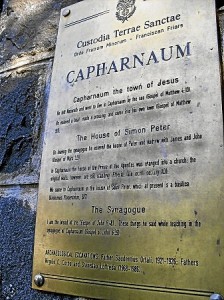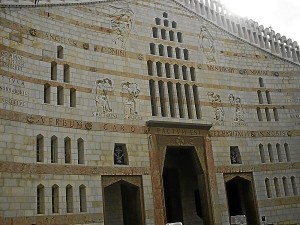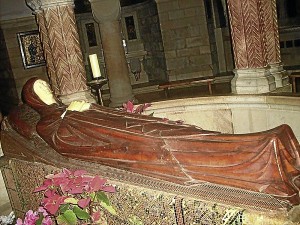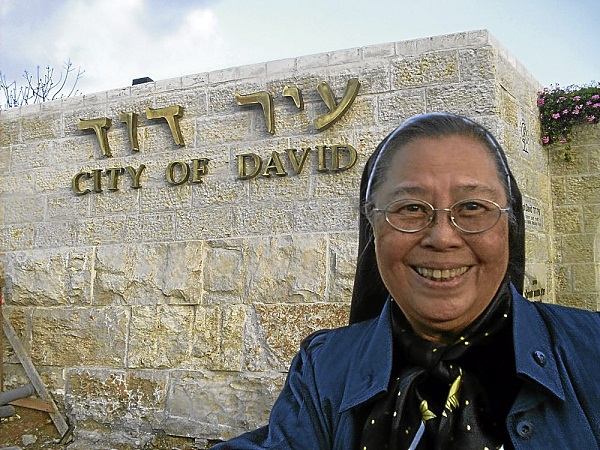
I visited the Holy Land for the first time in 1974, after I finished my studies in Germany and Rome. Thirty-seven years later, in January 2012, the Administrative Council of the International Organization of Benedictine Women decided to have its semi-annual meeting in Jerusalem.
I arrived on Jan. 14 and and stayed with the Contemplative Benedictine Sisters of the Mount of Olives. On Sunday, Jan. 15, at 7:30 a.m., we were ready for a walking tour of Jerusalem. Our first stop was a garden where you had a breath-taking view of the whole Jerusalem.
We started with the Way of the Cross as we entered the gate of Damascus, said to be the most beautiful gate in Jerusalem. This was the way Christ was supposed to have taken to calvary. We entered the Via Dolorosa and went through the souvenir shops right away.
I was shocked to see that the Way of the Cross was so far from my romanticized images of blue skies and open fields in a rustic setting. The Third Station was actually just a wall facing the souvenir shops, while the fourth station was an Armenian Church where there is picture of Christ meeting his mother. We went inside and prayed for mothers whose sons suffer torture and injustice.
At the Church of Notre Dame, we attended an English Mass. The priest, an American, gave a very good homily on corruption. I thought of the impeachment of Corona, the whistle-blowers, the cases against Gloria Macapagal-Arroyo.
After the ninth station, we entered a gate leading to the Church of the Holy Sepulcher. We went through a narrow door, and had to stoop because it was very low. We found ourselves in a big courtyard full of tourists, where our guide pointed to a tower-like structure where Golgotha was supposed to have been.

There was a big cross behind the very ornate altar with hanging lamps and candle-holders. We all stooped under the altar and kissed the spot where the cross of Christ was supposed to have stood. Then we went down to the lobby where there were frescoes of the crucifixion.
In the middle of the room was a rectangular stone where Jesus was supposed to have been wrapped in the shroud. We prayed for all our loved ones and friends who have died. A woman before us was sobbing the whole time.
We went back to the Notre Dame and ate lunch in their restaurant. The head waiter greeted me—“Kumusta ka?” Saying his wife was Ilongga, he proudly showed us her picture. He asked me to pray so they could have a child.
After lunch, we went to the Cenaculum or the place of the Last Supper. It was just a small hall with pillars and an altar. The Franciscans are negotiating to oversee the place and have daily Mass said there, which is fitting enough, since it was the place where the first Holy Eucharist was celebrated.
A man carrying water
Then we went to the Dormition Church, where a German priest explained to us the origin of the Church. He said something about the instruction of Jesus when looking for the room for the Last Supper, which I found interesting.
Jesus said, “Look for a man carrying water.” Why was that significant? Because usually men did not fetch water. That was women’s work. The fact that a man was carrying water showed that the area was probably in the community of the Essenes, who were not allowed to touch women. So they fetched their own water.
After the explanations, we went down to the crypt where the statue of Mary lying down was at the center of the circular room. This was not the tomb of Mary, which is somewhere in the Mount of Olives. This is only where she “fell asleep.”
We continued with the pilgrimage the next day.

Our first stop was Bethpage, where Jesus started the Palm Sunday procession to Jerusalem. We walked to Bethany, to Martha and Mary’s house. Interestingly, the town is now named after Lazarus.
There was a camel at the entrance to Lazarus’ house. The garden was full of trees, green grass, and flowers which we did not see anywhere else. The Church is called the tomb of Lazarus, although the actual tomb is elsewhere. I was just thinking, how come it is all about Lazarus? What happened to Martha and Mary?
In the Church we read the Gospel about Jesus raising Lazarus to life. It was an awesome experience to be listening to the Gospel event where it actually happened.
The next day, our guide said that since we did not see the City of David in our last outing, it was imperative that we made time in the afternoon to see it, because the City of David was the Jerusalem of Jesus’ time.
We walked until we reached the spring of Gihon, which was and is still is the source of water in the City of David. When the guide showed us two tunnels, they were filled with basura—oh my goodness, so much garbage in the City of David. Further on was the pool of Siloh, where Jesus cured the lame man. I dipped my shawl into the water.
We arrived at the entrance to the City of David, which is now a kind of commemorative park. This is supposed to be the palace where David lived and saw Bathsheba.
The next day, Jan. 19, we went to Galilee. We first stopped at a lookout with a panoramic view of the Judean desert—beautiful, undulating hills in different shades of brown. One can see a line of trees, and a stream running from Jerusalem to Jericho. Our guide pointed out the mountain where Jesus fasted for 40 days and 40 nights.

As we proceeded to Nazareth, we noticed how the landscape gradually changed from brown to green, from barren hills to plantations of palm trees, vegetables, and other vegetation. Nazareth, which in 1974 was only a village, is now a modern city. In fact, the first thing we saw on entering the city was a huge McDonald’s sign.
I recalled that on my first visit, Mary’s house was really a house. I remember seeing a naked little boy playing in the mud, and I recalled writing home that I imagined Jesus doing the same thing in his time.
A big church has been built, supposedly on top of the former house of Mary and Joseph. In the courtyard, there is a wall with a mosaic of Our Lady of the Annunciation, and below it was written: Philippines.
Loaves and fish
In the Basilica in Tabgha, there is the mosaic of loaves and fish on the floor in front of the altar, beside a rock where Jesus was supposed to have laid down the loaves and fishes brought by the little boy. In the basket, only four loaves are visible.
There are several explanations for this: One loaf was already eaten by the apostles, or it was actually beneath the other loaves. The more profound explanation is that the fifth loaf is actually the one consecrated on the altar during Mass. A Benedictine Father showed as around the new construction of their future cloister, and then we had the joy of eating lunch with the Filipina Sisters in their house. We enjoyed pancit, fried chicken, and tilapia. And siyempre, picture-picture after lunch.
We proceeded to the Church commemorating the episode when Jesus asked Peter three times, “Do you love me?” There is a beautiful iron statue commemorating this. We went down to the shore of the Sea of Tiberias, and read the Gospel narration which had a deeper meaning because again, we stood on the spot where it happened.

Capharnaum was where Jesus worked a lot of miracles. There we saw the church built on top of the house of Peter. I could imagine that Peter was president of their homeowners’ association there. In the middle of the ruins was the synagogue where Christ preached before he cured Peter’s mother-in-law. We still had time to go to the Church of the Beatitudes, where we prayed looking down at the sea of Tiberias.
The next day, we went to Ain Karem, the village of Elizabeth and where Mary went to visit her. Having gone to Nazareth, I realized how far Mary walked; they say it took her five days.
We visited the Yad Vashem, a museum of the Holocaust. It occupies hectares and hectares of land with different points of interest. We visited the place of remembrance of the 1.5 million children who perished in the concentration camps of the Nazis. This is a very moving place, all dark inside, and in the middle there are many flickering points of light like small stars.
We saw nothing except these points of light, and heard a voice announcing the names of the children who died. We also went inside the hall where an eternal flame was burning, and on the marble floor were etched the names of all the concentration camps where the Jews were killed. Then we entered the historical museum, which is very well-organized and has so many rooms it would take months to visit it completely.
Inhumanity
As we went from room to room, we were horrified by the brutality and the inhumanity of human beings to other human beings. There were pictures of the emaciated prisoners in their striped prisoners’ garb. We followed how the Nazis conquered country after country in Europe, all the time ferreting out the Jews and putting them in concentration camps, where most of them never came out alive. It was a sad but enlightening experience, strengthening my commitment to work for the oppressed and the persecuted.
In Bethlehem, we lost our way and had an unplanned tour. I now feel like singing not “O little town,” but “O big city of Bethlehem.” We finally found the house of the Sisters of Emmanuel, which is just beside the newly built wall. There are eight sisters here of different convents. The youngest novice, who is from France, actually biked all the way to Bethlehem from her hometown in Rheims. It took her four months to do so. That was her way of saying goodbye to the world, she said. Isn’t that something?
We had a wonderful sharing with them. And from their stories we got insights into the complicated situation here between the Israelis and the Palestinians. There is always an underlying tension, and the sisters live in uncertainty all the time, not knowing when violence will erupt.
After lunch they brought us to Beit Sahour, where the shepherds were supposed to have been watching over their flock when the angels announced the birth of Jesus. Again my memory of my first visit to this place was to a real cave, rustic and unadorned. What we saw was a church with paintings of the shepherds.
Then we went to the Church of the Nativity, which is the most un-church-like structure I have seen here, three churches built on top of each other. What is interesting was the last entrance made by the Crusaders, which is so low you have to bend in order to enter it. Our guide, Brother Stephan, explained that the Muslims at the time of the Crusades tended to bring their horses into the Church, desecrating it, so the Crusaders left only a small entrance to prevent horses from being brought in.
The interesting thing is the last pillar, with a painting of a woman, and under the picture is written Santa Incognita (unknown saint). The place is occupied by three communities: The Armenians, the Greek Orthodox, and the Franciscans. They live peacefully together and share the grotto, but have their own Churches of the Nativity.
The grotto houses the place where Jesus was born, and the manger where he was put after he was born is marked by a glass star.
In our last programmed tour, our destination was Abu Ghosh. This is one of three places claiming to be the Emmaus, where two disciples were going home after the death of Christ, very disappointed because they thought their expectations were not fulfilled. Then Jesus appeared and walked with them along the way and explained to them all about the scriptures, and finally they recognized him when he broke the bread, and their eyes were opened.
When I asked about the meaning of the name, a gentleman who attended the Mass told me that the family Abu Ghosh used to dominate the village, and everyone had to pay taxes to them. Over the course of time the word Ghosh somehow came to mean “thief.”
In 1143, the Crusaders identified the site of the village of Emmaus, and built the Church on the foundation of the Roman reservoir. It was occupied by the Muslims, and they erased the faces of the figures painted on the walls. In 1900, a monastery was built by Benedictine monks.
We attended High Mass at the present monastery, very solemn, with the nuns wearing white full-length veils that fell gracefully to the ground. I was ecstatic to be able to sing with them the Gregorian chant for the proper as well as the common parts of the Mass.
Beautiful ritual
Before meals, the nuns have a very beautiful ritual for their guests. At the door of the refectory, the Prioress (who has been in office for 35 years, since the convents’ foundation), assisted by another sister, washed our hands one by one, dried them, and kissed the palms, while the other sisters were chanting in their places in the refectory.
The meal was eaten in silence. I have never eaten so much cheese and olives as in these 10 days!
The next day we decided to go to the old city by ourselves. We went down at the gate of Damascus and followed the Via Dolorosa to do some shopping, where I got a taste of local haggling to buy an “I love Jerusalem” T-shirt. We bought dates, pistachios, and some sweets, then Sr. Mary Jane said we should try Turkish coffee. I thought it would be bitter like espresso, but it was not. It had some cardamon in it, and is brewed in a special way in a special pot.
My last day was a memorable one. Sr. Benedict of the community accompanied me to the holy places around the Mount of Olives. We went first to the Mosque, which has the little Church of the Ascension, where Jesus was seen to have ascended into heaven. Then down the street, just in front of our convent, is the Carmelite monastery that houses the Mount of the Our Father.
Here Jesus was supposed to have taught the Our Father. Everywhere there are signs showing the Our Father in all languages, including Tagalog, Pampango, and Cebuano. Inside the crypt which houses the rock where Jesus must have sat, I prayed the Our Father in Tagalog and English.
Inside the Catholic church in Gethsemane, I kissed the rock where Jesus was supposed to have sweat blood. As I sat in front of it, I was filled with such feelings of peace and unction that I stayed seated for some time, just aware of the sensation. We passed by the gnarled olive trees in the garden that must have been about 2,000 years old.
On the opposite side of the garden there is another small church, where Judas betrayed Jesus with a kiss. In all these places I joined the sufferings and agony of our people, especially the victims of typhoons, extrajudicial killings, and unwanted disappearances, to the tears and agony of Christ.
I revisited many places in the Holy Land, but felt as if I was seeing the places for the first time. So much has changed—but maybe much has changed in me, too. And so I saw the places with new eyes and experienced a new fervor. Looking at these holy places can result in disappointment when your idealized pictures are shattered, but one also comes to one life-changing realization: That God did become a human being, and dwelt among us.














































